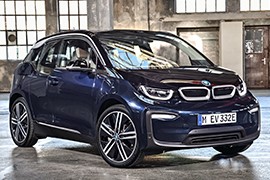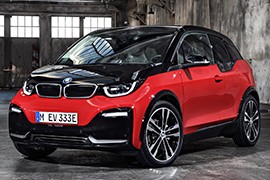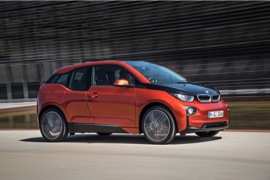BMW i3 Models/Series Timeline, Specifications & Photos
First production year: 2013
Engines: Electric, Hybrid
Body style: Hatchback
Due to its unusual shape and distinctive interior, the BMW i3 was either a car you liked or you didn’t. There was no in between.
The 4-door hatchback offered seating for four and was one of the most practical, yet premium EV.
The potential of the i3 was greatly maximised with its made shell made entirely of carbon fiber, a material that was stronger than steel and lighter than aluminum.
For 2017, BMW introduced a larger battery to improve the driving range. It was available for 2 out of the 3 trim levels available, namely the base and the Range Extender version.
Inside the i3 was a roomy interior, with a comfortable seating position. Quietness defined the i3’s cabin in the all-electric mode, with the only exception being the gas generator running when the battery was discharged.
While lots of storage spaces were available in the cabin, the i3’s cargo area was a small size and loading heavier items was made uneasy with the high position of the trunk.
The i3 was equipped with a standard business navigation. Optionally, a professional navigation was available, with a bigger screen and a hard-drive map data.
An available packaged named Technology + Driving Assistant included adaptive cruise control, forward collision warning with collision mitigation. A parallel parking system was available as a stand-alone feature.
After its launch, the BMW i3 evolved and topped the charts among the electric car sales around the world. It was the most sold premium electric vehicle in the world. In 2017, a new version was launched: the i3s.
BMW sporting heritage is known. The introduction of an electric vehicle in its range was surprising, but when the little i3 was compared from the performance-wise to other electric compact vehicles, it proved to be sportier. The i3s came to add more to the already nimble i3.
The i3s came along with new color options, including a red and black theme. It also featured a new, exclusive, 20” wheel design. There were few other small details such as reshaped bumpers and a sport suspension that lowered the ground clearance by 10 mm (0.4”) and wider track by 40 mm (1.6”). For the headlights, new full-LED units were installed for both low- and high-beams.
Inside the i3s the design and the materials used were premium, eucalyptus unpainted wood. The natural fiber used for the upholstery also were wood-based. The instrument cluster was a full TFT display. The i3s was roomy and provided easy access due to the four doors and the rear doors were read-hinged.
With a bigger power and an adjusted DTC (Dynamic Traction Control) mode that boosted agility at higher speeds and during sporty cornering. And, according to the official press release, it even allowed “mild and safely controllable drifts when grip levels are reduced”.
When BMW introduced the i3 on the market in 2013, it sent a shockwave in the premium segment, and it was a clear sign that the carmaker would join the electric revolution.
With its minivan shape and short external dimensions, the i3 made the carmaker's fans split between those who loved it and those who hated it. Yet, the car's size was an important advantage for city usage. Its front was short, and even if it sported the same kidney grille that was no longer used to cool an engine behind it.
The car's headlights were swept back on the sides but still featured the same signature DRL with "Corona lights." One of the most unusual features of the car was the doors. When opened, there was no B-pillar. The rear ones were shorter and rear-hinged, easing the ingress and egress. At the back, the tailgate sported high-mounted taillights, protected from bumps in the parking lot.
The interior was even more unusual, with a pair of screens: one TFT for the instrument cluster and a second one for the infotainment system. To create a premium feel while still keeping track of the environmentally-friendly materials, BMW used only naturally-treated leather, wool, wood, and recycled materials for the cabin.
But the biggest revolution was for the drivetrain. BMW designed the car as an EV right from the start. Thus, it created a platform that integrated the battery pack. Even though it was a rear-wheel drive vehicle like most of the other BMWs, it featured a rear-mounted motor placed under the trunk's floor. For those who feared the electric-only autonomy, the carmaker added a two-cylinder internal-combustion engine that served as a power generator and could replenish the batteries. For the EV-only versions, the carmaker offered a choice of two battery packs, which gave the 170 hp vehicle a range of up to 180 km (112 miles). At the same time, the version fitted with a range extender could travel up to 300 km (186 miles).


